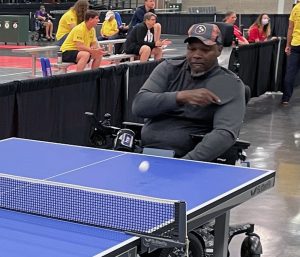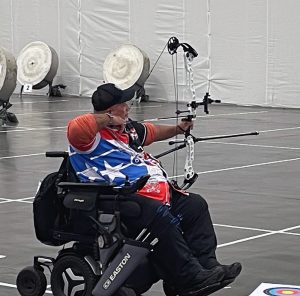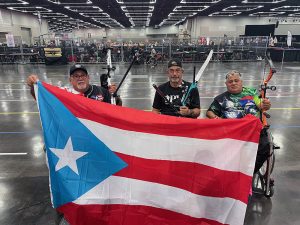Veterans take on table tennis and archery at NVWG
Table tennis balls and archers’ arrows flew through the air on the third day of the National Veterans Wheelchair Games (NVWG), co-sponsored by Paralyzed Veterans of America (PVA) and the Department of Veterans Affairs, in Portland, Ore.
For the single-elimination table tennis event inside the Oregon Convention Center, each game went to 11 points, and players had to win by two. Matches were the best of five games.
Royal Navy veteran Ian Stuart came all the way from Cumbria county in Great Britain for his 10th NVWG. One of just five other wheelchair athletes from the country, the 62-year-old, who served from 1980 to 1988 and sustained a level C5 incomplete spinal-cord injury (SCI) in 1986 after diving into shallow water, says he isn’t fantastic at table tennis but likes to play.

“For some reason, because it’s sort of one-on-one like tennis, I concentrate more,” he says. “I find it more of a contest, rather than 9-ball [billiards], where you’re playing the ball. You’re actually playing somebody. That’s what I like. It makes me a bit tense actually. I don’t get that with any other sport, the ones I do.”
He lost his first table tennis match but won his second against last year’s Spirit of the Games award winner Davis Celestine. He says 9-ball is his favorite sport. But he also planned to compete in boccia for the first time on Saturday.
“I don’t know what that is, but I’ll find out tomorrow,” he says.
Stuart doesn’t get to play table tennis often since his friends’ work schedules make it difficult to find someone play against, but he practices 9-ball because he can play on his own.
“Something like 9-ball, you know all the angles and how it works, you only need a few hours and you’re back in the groove with it,” he says. “Something like table tennis, to improve, I think I would need a coach. I’m probably doing everything wrong.”
As for his table tennis strategy, he analyzes the first few rallies to see if his opponent’s forehand or backhand hits are weaker.
“I like to sometimes, if I can, just get it over the net, rather than just hit it back — concentrate on just getting it over the net where they can’t reach,” he says. “The first guy I played, he was good. He had a reach like an orangutan. I couldn’t believe it.”
Stuart enjoys everything about the Games.
“If you get a medal and you feel as though you’ve done your best to get it, you’ve tried,” he says.
Like Stuart, PVA Mid-Atlantic Chapter member Ronald Richardson doesn’t get to play table tennis very often, but he likes the back-and-forth action. An Army veteran who served from 1983 to 2006, he sustained level T4-T6 and T11-T12 SCIs in a 2004 motorcycle accident. Besides playing table tennis, Stuart was also competing in bowling, boccia and air rifle at the Games in his power wheelchair.

“Believe it or not, when I started the Games, I was in a manual chair, so I could move around a whole lot better,” says the 64-year-old Fayetteville, N.C., resident, who was attending his 10th NVWG. “In this power chair, you’re pretty much restricted because it’s not going to let you move that much, so you just move your arms. But I still love to play.”
Although he lost his first match, he was still all smiles afterward.
“When my game really is on, I can smash fore[hand] and backhand, just to see the reaction of the other guy,” he says.
In addition to table tennis, he’s also played traditional tennis, both able-bodied and in a wheelchair, and says learning to play in a wheelchair gave him more motivation.
“When I was able to play in a wheelchair, that just refined everything,” Richardson says.
Meanwhile, the archery competition saw competitors shooting 10 ends (rounds) of three arrows each. Archers has two minutes to complete each end and could shoot with either a compound or recurve bow. Novices shot at targets 10 meters away, and the other classes shot at 18 meters.
Army veteran and PVA Puerto Rico Chapter member Oscar Velez, who lives in Camuy, Puerto Rico, brought his own compound bow and arrows to shoot in his 11th NVWG.

The 68-year-old served from 1975 to 1977 and sustained a level T10 SCI in a 2007 car accident. He says he liked watching people do archery since he was a little boy, but he only started practicing after his injury.
He doesn’t let the time clock pressure get to him during competitions.
“The pressure makes you stronger,” he says. “I think do better with pressure.”
Velez scored 281 out of 300 points, but thinks he can do better. Back home, he usually shoots his bow outside at 40 to 50 meters and without any adaptations.
He was also competing in air rifle, air pistol, disc golf, slalom, javelin and discus, but he says archery is his favorite.
“I’m relaxed and I’m by myself,” Velez says. “Forget about everybody else and don’t let nothing bother me when I’m shooting.”
The NVWG runs through Sunday, July 9.



